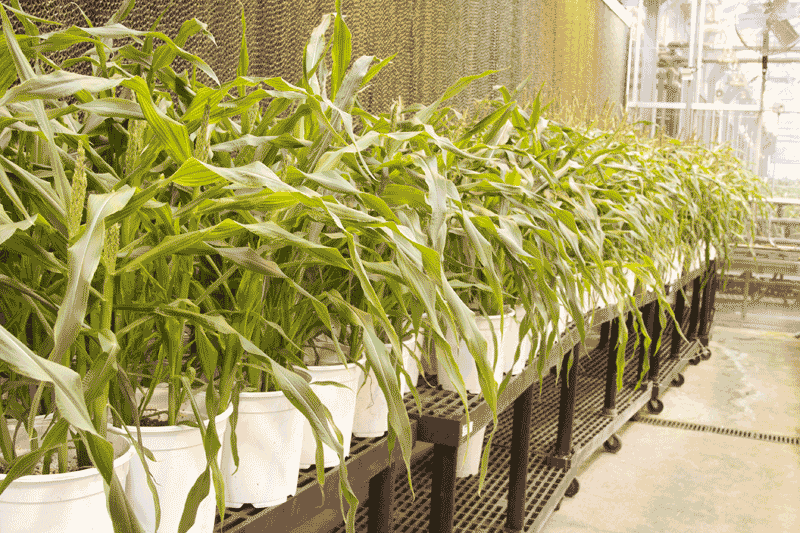Understanding biotechnology
A TOUR OF A DUPONT PIONEER PLANT BREEDING FACILITY
FOR A GENETICALLY modified (GM)?plant, the road to commercialization is long and tedious, but extremely interesting. From discovery to launch, it takes GM products anywhere from 12 to 20 years to hit the market. Their development costs the industry, on average, about $140-million. Ever wondered what goes on inside a plant breeding facility? How are genes selected? And once selected, how do they get inside plants? Most importantly, how are those plants tested for tolerance and resistance?

A visit to DuPont Pioneer’s Johnston Beaver Creek Campus in Iowa reveals what goes on inside their world-class breeding facility.
PLANT BREEDING IN THE PAST
Back in 1926, when DuPont Pioneer first started out in plant breeding, scientists bred exclusively on phenotype, examining visible characteristics like height, ear girth and cob colour. However, there were problems with breeding exclusively based on phenotype, says DuPont Pioneer’s Visitor & Stakeholder Outreach Coordinator, Ashlee Stoddard.
“If the environment isn’t perfect for the particular study that you’re doing, you’re not going to get a good idea of whether that plant has the characteristics it needs to be able to resist those environmental pressures.”
Today, plant breeding is much more sophisticated. Scientists screen DNA and isolate individual traits that control for drought tolerance, or insect, disease and weed pressure.
THE SCIENCE
In order to understand plant transformation, you need a quick lesson in biology.
Every plant cell contains a nucleus and within that nucleus are chromosomes, or tightly coiled DNA that transmit heritable characteristics from one generation to the next. Within the DNA are very specific sections called genes, and genes are what control individual traits.
Corn, for instance, has many traits, including height, ear length, ear placement on the plant, leaf structure and colour. A gene, or a combination of genes working together, known as a sequence, controls each of these traits.
INSIDE THE LAB
To find unique genes or sequences that may be useful for plant breeding, plant breeders from around the world send samples of leaf material into DuPont Pioneer’s lab for analysis. Plants are tagged so that the results can be traced back to the field from where they were taken. These DNA samples are then analyzed for known and unknown sequences.
Scientists have a database of “known sequences,” which they use to compare to those found in samples they have collected. In the search for resistance, whether it be plant or disease, if a sample’s sequence matches known sequences, then scientists know that the plant will not be resistant. However, if the sequences are not a match, resistance is possible.
Once those markers are identified, scientists will extract and transfer the gene sequence into the germplasm of a plant product to conduct further testing. Plant transformation is done using two types of technology: gene guns and agrobacterium.
“Early gene guns actually used .22 caliber bullets [coated in genetic material] to shoot the genes into the plant embryos they were trying to transform,” says Stoddard. “As you can imagine, this approach wasn’t entirely accurate.”
Gene guns were later modified to use compressed helium, which still was not accurate. Today, most plant breeders use agrobacterium for plant transformation.
“Agrobacterium is a bacterium that we can insert our gene of interest into,” says Stoddard. “When combined with the embryos of the plant we’re trying to transform, the agrobacterium will move that gene of interest into the embryo at the cellular level.”
Lab technicians will then grow that embryo into a callus, which is essentially a clump of undifferentiated cells that don’t know what they want to be when they grow up. Calluses are plated onto a jelly-like substance called a “selectable growth medium” and grown until they are big and healthy. Natural plant hormones are applied to the cells, causing them to grow shoots and roots. Eventually, the tiny plants are taken to the FAST corn greenhouse to continue their growth. FAST corn, which stands for Functional Analysis System for Traits, matures in just 86 days – twice as fast as standard field corn – making it ideal for testing.
“We’re using this product for our transgenic research because it gives us a quick and early preview of how those traits are going to perform in a plant,” says Stoddard.
INSIDE THE GREENHOUSE
What looks good at the genetic level might not look as good once it is subjected to environmental stresses. It is, after all, the combination of the genetics and the environment that ultimately determine the phenotype of that plant – what it looks like, how it performs, and its agronomic characteristics.
Within the greenhouse, environmental conditions, including lighting and humidity, are controlled year round. At any given time, there are up to 5,000 plants in the greenhouse, each with its own experiment going on. Environmental stresses include drought-like conditions, insect pressure and nutrient deficiencies.
In DuPont Pioneer’s Mendel Greenhouses, for instance, lab techs test FAST corn genetics under their insect pressure program. The program simulates high-pressure insect environments that exceed what the plant would experience under normal circumstances. Colonies of six problem insects, including the European corn borer, are grown and reared on-site specifically for testing.
Once the plants have been subjected to pressures, it is time to see how they have fared. For further analysis, they travel by conveyer belt through a fixed system that contains a series of three cameras: a fluorescent camera, a high-resolution camera, and a hyper spectral camera.
The fluorescent camera shows how well the plants are photosynthesizing. The high-resolution camera captures images from several angles to generate a three-dimensional model, displaying the plant’s height, width and leaf architecture. And the hyper spectral camera detects plant stress long before it is outwardly visible in the plant itself. Plants pass through this imaging system up to every 48 hours. Data is collected and analyzed.
The greenhouse is an important tool for screening some of those early-stage prospects, so that scientists know they are focusing their energy on transgenes that have the most potential to be commercialized to market.
“If it looks good, we’ll continue research,” says Stoddard. “But if it looks bad, we’ll stop research early.”
THE REGULATORY PROCESS
Once a genetically modified plant passes all internal tests, it will then be tested in the field. Before it can be commercially sold, it has to go through the regulatory process, as well. The regulatory process is both long and expensive. But despite the cost and the time it takes, DuPont Pioneer is firmly committed to the process.
“We think it’s crucial to product development,” says Stoddard. “It’s giving government’s around the world a chance to see our science in action. We do tests internally here at DuPont Pioneer so that we know our products are safe for people and the environment. But the regulatory process gives governments around the world the chance to see the same thing.”
Among other things, DuPont Pioneer is currently looking at nitrogen utilization efficiency and drought tolerance in corn. •






















